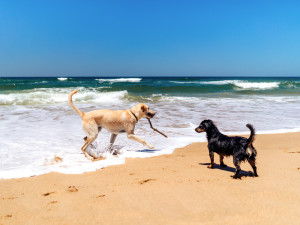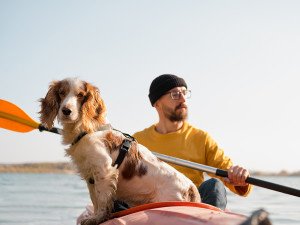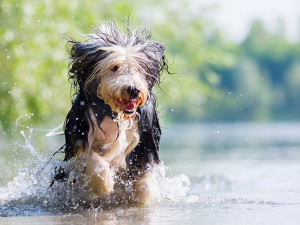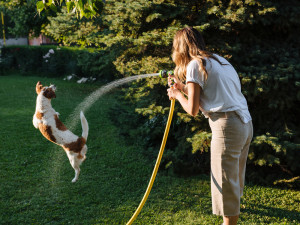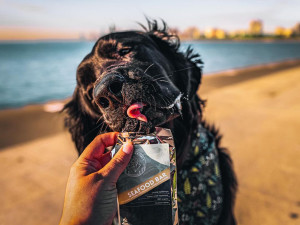Go Paddleboarding With Your Dog
Veterinarian Shea Cox provides some practical tips for SUPing with your pup.
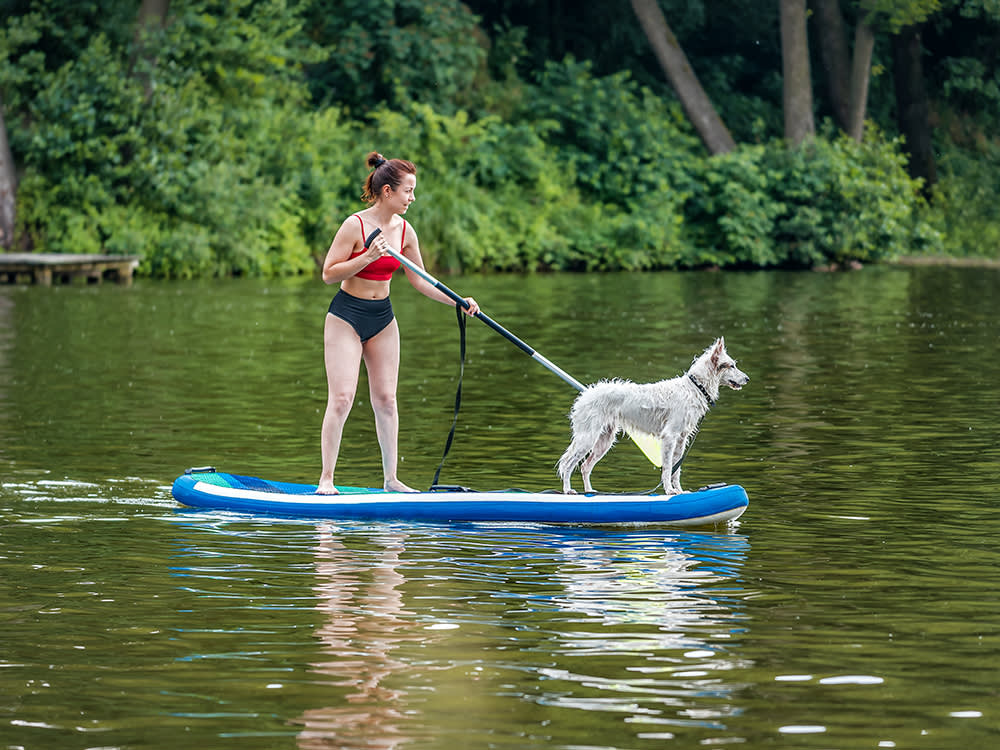
Share Article
Standup paddleboarding has seen a huge wave of interest in recent years, and as more people take to the sport, it’s likely their dogs will, too. “A standup paddleboard just happens to perfectly fit one person and one dog,” says Pearlberg, owner of Santa Cruz Stand Up Paddleboard Co. “Plus, you get a dog on a standup paddleboard, and they just seem to know what to do.” Some dogs sit between their person’s legs, ears flapping. Others stand at the front of the board like hood ornaments, tongues flying. Some even scurry back and forth as though their movements could help propel their vessel. One thing is for sure — it’s a lot of fun.
What is Standup Paddleboarding?
Standup paddleboarding, also known as SUP, an ancient form of surfing, has its origins in Hawaii. And before it had a name, it was the way surf instructors gained perspective to observe students and read the incoming swells. Standup paddleboards, which resemble surfing’s longboards, stretch 10 to 12 feet and are geared more toward balance than speed. A single long-necked paddle is used to move the board through the water.
The sport has exploded in the last decade, thanks to celebrity advocates like big-wave surfer Laird Hamilton, and the fact that, unlike most board sports, paddleboarding with dogs is easy to get the hang of. It’s not overly technical — doesn’t require a high fitness level — and can be done on lakes, rivers, the ocean, still water, or in waves. For pet parents, it opens up a whole new way to experience water sports with their pup.
Can Your Dog Paddle Board?
“Any dog can do [standup paddleboarding],” says San Diego-based dog trainer Lara Schindler. She started her Portuguese Water Dogopens in new tab, Snorkel, on a standup paddleboard when he was four months old, but says dogs of any age can get involved; they don’t need to be puppies. “This is one activity where the type of dog really doesn’t matter,” she says. “They can be any age, any breed, even any size. I’ve seen people SUPing with 100-pound dogs.” But to be sure your pup is a good fit, it’s best to check with your veterinarian.

How to Get Started Paddleboarding With Your Dog
What matters for paddleboarding with dogs, according to Schindler, is making the dog’s first experience with the board a positive one. She suggests starting slowly on land, ensuring that your dog knows the basic commands — “sit,” “stay,” and “down” — before you go on the water. “You don’t want the dog to be afraid of the board or the water, and you need a way to [keep] them from just jumping off the board whenever they want,” she explains.
Practice in placid water.
Schindler also recommends starting on a bay or a lake, as it can be tricky to maintain your balance in waves, which makes it scarier for your dog. Schindler teaches people to standup paddleboard with their dogs in one-hour private lessons. She says that’s about as long as it takes, even for people and dogs with no prior standup paddleboarding experience.
Balance is your goal.
The trickiest part is balance. Adding your dog’s weight and movement can make maintaining your own balance a challenge, but with a bit of practice, it will be the most fun you’ve ever had with your dog. Outfitting your dog in a life vest will help your peace of mind if they accidentally fall off and give you a handle to lift them back on the board.
Go at your dog’s pace.
Standup paddleboarding instructor Linda Brown, owner of Michigan-based Paddle the Mitten, echoes Schindler’s thoughts on the ease of learning the sport, but says every dog is different. All three of her Dachshundsopens in new tab enjoy SUPing on Michigan’s inland lakes, but learned at different paces. Kraut, the six-year-old, took to it immediately, and charges right up to the front of the board. The youngest, Gretchen, was the shyest. “Her first time out, she did fine until she realized the other two were still back on the shore,” Brown says. “Then, she jumped in and swam back.”
SUP Dog Safety Tips
Veterinarian Shea Cox provides some practical tips for SUPing with your pup.
1. Wear a lifejacket
Make sure your dog’s life jacket fits properly and let them get used to wearing it, both on land and in the water, before you go out on the board.
2. Take water breaks
Have water available and offer it frequently. If your dog gets thirsty, they may try drinking salt water, which can lead to toxicity. A few gulps won’t hurt, but watch for vomiting and early neurological signs of salt poisoning, such as dullness and depression.
3. Keep their paws and coat clean
Salt can be irritating to paws and skin, too. Rinse salt water and sand from your dog’s coat after a swim, and always clean and dry their ears. Water trapped in the ears can result in a bacterial ear infection, particularly if the water is at all contaminated.
4. Watch out for sunburns
Dogs, especially those with short hair, white fur and pink skin, can easily sunburn. Some dogs have just a thin coat of hair on their bellies, and reflected light from the water can burn their undersides as well. Limit your dog’s exposure during peak sun hours and apply sunblock to the ears and nose (and belly, if needed) 30 minutes before going outside. Dogs can be protected from sunburn by vests that block ultraviolet rays and sunscreen made with dog-repellent ingredients to keep them from licking it off.
5. Goggles are helpful
Goggles for dogs are a thing. If your dog is predisposed to eye problems, you may want to invest in a pair of Doggles to protect their peepers.
6. Hot sand can be a problem
Running on sand is strenuous exercise. A dog who is out of shape can easily pull a tendon or ligament, so keep a check on your dog’s activity. Hot sand can also blister tender paw pads.
7. Sea life isn’t always friendly
Scan the water and sand for jellyfish. Be aware that sea lice can cause itchy red bumps on dogs.
8. Look for signs of heatstroke
Never, ever leave a dog unattended in your vehicle in the summer months. Heatstroke and death can occur within minutes in warm temperatures.

Jayme Moye
Jayme Moye is an award-winning journalist who writes about the people, places, ideas and events that are changing the way we think about the world. She is a Senior Writer with Kootenay Mountain Culture and her freelance work regularly appears in Outside, Canadian Geographic, National Geographic, and Condé Nast Traveler, among others.
Related articles
![A man paddling on the water in a canoe with his dog.]()
How to Safely Make Your Dog Your First Mate
You’re on a boat, but does your dog want to be there, too?
![Bearded Collie running in a lake]()
When Drinking Too Much Water Is Deadly
How to keep your swim fan safe.
![A woman spraying her excited dog with a garden hose in the grassy backyard]()
7 End-of-Summer Activities for You and Your Dog
Stay cool (and safe) out there.
![A black dog on the beach taking a bite out of a seafood bar dog treat.]()
8 Protein Bars That Will Have Your Dog in Better Shape Than Jason Momoa
The meal supplements are no longer reserved for gym rats — active canines can also indulge in the quick treats.


